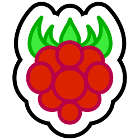The RPi.GPIO Python library allows you to easily configure and read-write the input/output pins on the Pi’s GPIO header within a Python script. Thankfully this library is now including in the standard Raspbian image available from the Foundations Download Page. If you are using a fresh image you don’t need to install it but I’ve kept the instructions here in case you ever want to try a manually installation.
Author: Matt
My first attempt at Python programming was a script to send email. This is something I planned to use in a future applications so I thought it was a good first step.
By default the Raspberry Pi has its hostname set to “raspberrypi”. This appears as part of the command prompt when you open a terminal window. It only takes a few minutes and you’ve got a choice of two methods. I sometimes change the hostname so that when I list devices on my home network I can easily identify any Raspberry Pis I’ve got connected amongst all the phones, tablets and PCs.
The Pi has a number of connectors that allow you to power it and connect various peripherals. This is fairly straightforward for people familiar with the connectors and cables required to use them. For the benefit of anyone who isn’t familiar with HDMI, DVI, USB, audio or MicroUSB cables I have created the following visual guide to help you find cables and adapters you may have sitting in a drawer gathering dust. Pi Connector Suggested Cable Description Audio 3.5mm Jack A 3.5mm jack plug to 3.5mm jack plug cable would allow you to connect the Pi’s audio output to a…
Here you will find mechanical drawings for all models of the Raspberry Pi including the Pi 3, Pi 2, Pi Zero, Pi Zero W, B+ and A+ as well as the original Pi Model B. The drawings show the position of major components with dimensions.
As explained in the Raspberry Pi Initial Hardware Setup there are some bits of equipment that you need to get started. This page covers some of the other items you can connect to the Pi to get the most out of this amazing piece of technology. Using USB there is a large range of existing USB devices ready to enhance your Raspberry Pi projects and you may already have access to some of them.
In order to start using your Raspberry Pi you will need a few other bits of equipment. The Pi is supplied on its own so you will either need to have these items available or buy them. Luckily none of the items are particularly expensive and you will possibly have a few of them already.
The Raspberry Pi has no on-board storage and requires a suitably prepared SD card in order to function. The SD card contains the operating system which the RPi loads when the power is switched on. You can either purchase an SD card from the RaspberryPi.org website (when available) or prepare a card yourself. Creating a card yourself is a fairly easy process.
The Raspberry PI is a single board computer not much bigger than a credit card. It has been developed by The Raspberry PI Foundation, a UK based charity (Reg. No. 1129409). It can be connected to a keyboard, mouse and display turning it into a powerful yet small PC. It is capable of running a huge range of existing applications including word processors, spreadsheets, games and web browsers. It’s processor can handle HD video decoding allowing it to play full screen HD video.
The RPi is available in two models. Model A and Model B. They are very similar but the cheaper Model A does not include a network port and only provides one USB port. The Model A was expected to be used more widely in schools due to its lower cost but the lower power consumption may also make it ideal for other projects. The table below shows the hardware specification of both models : Model A Model B Price US$25 (GBP £20) US$35 (GBP £28) System (SoC) Broadcom BCM2835 (CPU + GPU + SDRAM) CPU 700 MHz ARM11 ARM1176JZF-S core GPU…
Here is a list of terms that you might come across when reading about the Raspberry Pi. Many of them are standard computing expressions but are particularly relevant in the world of the RPI. I will update this page when I think of new terms that might be useful to people.
Unofficial site devoted to the Raspberry Pi credit card sized computer offering tutorials, guides, resources,scripts and downloads. We hope to help everyone get the most out of their Pi by providing clear, simple articles on configuring, programming and operating it. You will also find information about the BerryClip addon boards, the easiest, cheapest way to start experimenting with hardware and software.
